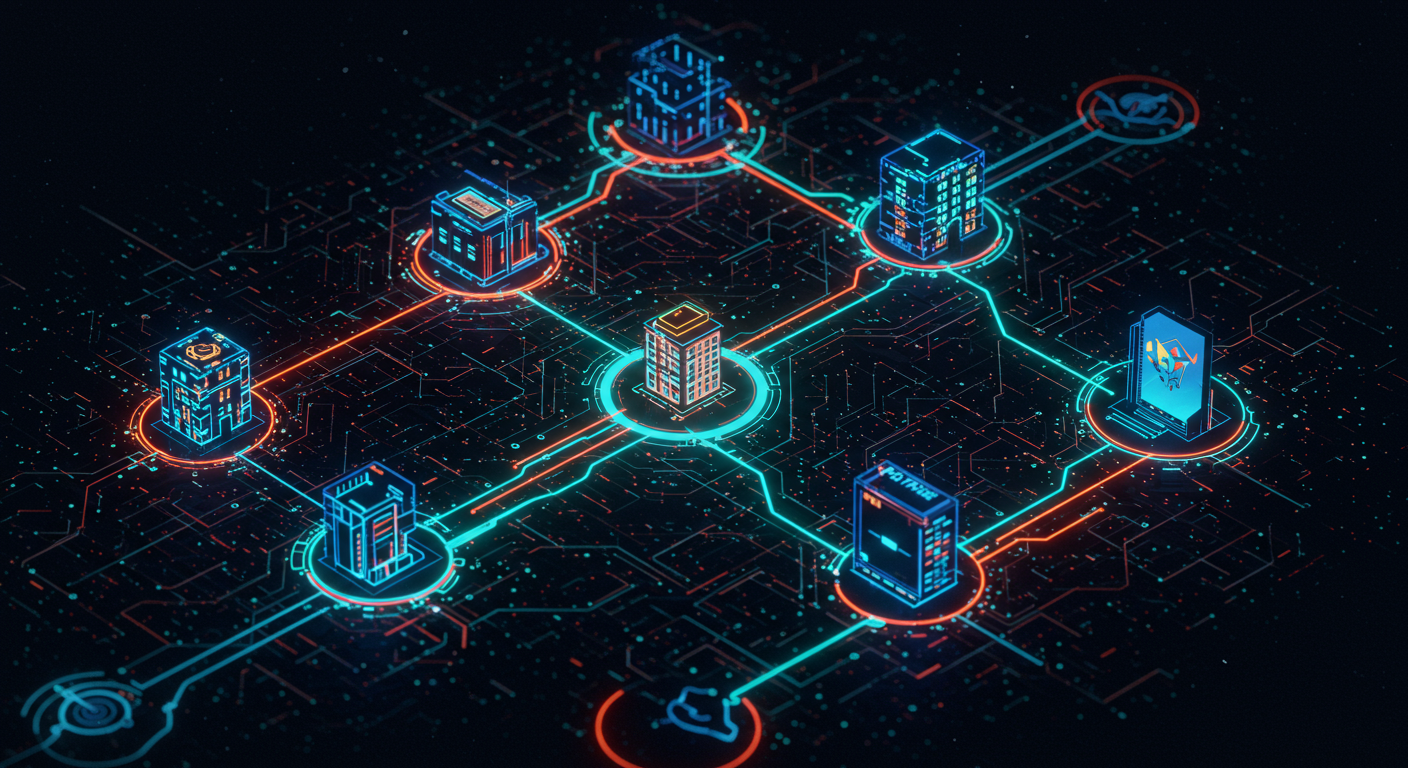Unlocking Property in the Digital Age: A Deep Dive into Polytrade and Tokenized Real Estate
John: Welcome, everyone. Today, we’re diving into a topic that sits at the fascinating intersection of tangible assets and the digital frontier: tokenized real estate. It’s a concept that promises to democratize property investment, and one company, Polytrade, has been making significant waves. They recently announced a major strategic funding round, bringing their total raised to over $6 million, specifically to expand their real estate tokenization infrastructure. It’s a pivotal moment for what we call Real-World Assets, or RWAs.
Lila: That sounds huge, John. But let’s start with the basics for readers like me who are just getting up to speed. When you say “tokenized real estate,” what does that actually mean? I’m picturing a digital deed for my house, but I feel like it’s more complex than that.
John: That’s a great starting point, Lila. You’re on the right track. In simple terms, tokenized real estate is the process of creating a digital representation of a real-world property on a blockchain. This digital representation is called a token. Instead of one single, indivisible deed, you can have thousands or even millions of these tokens, each representing a tiny, fractional ownership stake in that property. It’s about converting an illiquid asset—a building that’s hard to sell quickly—into a collection of liquid digital tokens.
Lila: So, it’s like instead of needing a million dollars to buy a commercial building, I could buy a one-thousand-dollar ‘share’ of it, represented by a token? That really does sound like it could open up the market to a lot more people.
John: Precisely. It breaks down the high-cost barrier to entry that has kept real estate investment exclusive for so long. This is the core revolution Polytrade and others are championing. They’re not just building a platform; they’re building the infrastructure to make this process seamless, secure, and accessible on a global scale.

The Foundation: Basic Info on Polytrade
Lila: Okay, so let’s focus on Polytrade. The search results call it an “aggregator” and a “marketplace for tokenized Real-World Assets.” What’s its story? Where did it come from?
John: Polytrade has an interesting evolution. It initially started as a trade finance protocol, aiming to solve liquidity issues for small and medium-sized enterprises in the supply chain world. However, they recognized the immense, untapped potential in the broader RWA market, especially real estate. They pivoted and expanded their vision to become what they are today: a comprehensive marketplace for a variety of tokenized real-world assets, with a strong, new focus on real estate. Their goal is to be a one-stop-shop where users can discover, trade, and manage these new asset classes.
Lila: A pivot from trade finance to all RWAs is quite a leap. Does that show ambition or a lack of focus? And what does being an “aggregator” mean in this context? Are they like the Zillow or Rightmove for tokenized properties?
John: It’s a fair question, and I’d argue it shows ambition rooted in a deep understanding of the underlying technology. The core problem—unlocking liquidity from illiquid assets—is the same. Your Zillow analogy is excellent. As an aggregator, Polytrade doesn’t tokenize every property itself. Instead, it partners with various real estate funds and tokenization platforms, bringing their assets onto a single, unified marketplace. This provides users with a wider selection and a standardized experience, rather than having to jump between dozens of different platforms with different rules and interfaces.
Supply and Demand: The Assets and the Token
Lila: That makes sense. So, if they are aggregating assets, where do these tokenized properties come from? Who decides that a building in, say, Dubai or New York gets listed on Polytrade? And how can users be sure these are legitimate, high-quality investments?
John: That’s the critical question of due diligence. Polytrade’s model relies on partnering with established real estate entities, funds, and specialized tokenization companies. These partners are the ones who handle the on-the-ground work: identifying promising properties, conducting legal and financial vetting, and managing the physical asset. Polytrade, as the aggregator, then performs its own layer of due diligence on these partners and the assets they bring. The recent news highlights they are already in talks with funds across the UAE, EU, and Asia. This vetting process is paramount to building trust. The supply consists of a curated selection of assets, from residential apartments to commercial buildings and even plots of land.
Lila: And what about Polytrade’s own token, TRADE? How does that fit into this ecosystem? Is it just for governance (the process of allowing token holders to vote on a project’s future), or does it have other uses?
John: The TRADE token is designed to be the utility backbone of the ecosystem. While many protocols use tokens for governance, Polytrade aims for deeper integration. It can be used for things like:
- Staking: Users can lock up their TRADE tokens to earn rewards, which helps secure the network and provides them with passive income.
- Access to exclusive deals: Holding a certain amount of TRADE might grant users early access to new property listings or lower transaction fees.
- Platform fees: Fees for trading or listing assets on the platform could potentially be paid using TRADE, often at a discount.
It’s about creating a circular economy where the token’s value is intrinsically linked to the activity and success of the marketplace itself.
The Technical Mechanism: How It All Works Under the Hood
Lila: Okay, let’s get a bit more technical. I hear terms like “blockchain,” “smart contracts,” and “modular tech stack.” Can you break down how a physical building in London becomes a tradable token on my screen? Walk me through the process.
John: Absolutely. It’s a multi-step process that bridges the physical and digital worlds.
- Legal Structuring: First, the physical property is placed into a legal entity, often a Special Purpose Vehicle (SPV), which is a subsidiary company created solely to hold that asset. This isolates the property legally.
- Tokenization: The ownership shares of this SPV are then digitized and represented as tokens on a blockchain, such as Ethereum or Polygon. This is the core tokenization step. Each token is a legal claim to a fraction of the SPV, and by extension, the property it holds.
- Smart Contracts: This is where the magic happens. A smart contract (a self-executing contract with its terms written directly into code) is created for the asset. This contract governs everything: how tokens are issued, how rental income is distributed to token holders, rules for trading, and even voting rights on property decisions. It automates processes that would traditionally require lawyers and administrators, drastically reducing costs and friction.
- Platform Integration: Finally, this tokenized asset is listed on a marketplace like Polytrade. The platform provides the user interface to browse, buy, and sell these tokens, interacting with the underlying smart contract on the user’s behalf.
- Use property tokens as collateral: As you said, borrowing stablecoins against your real estate holdings without going through a bank.
- Portfolio diversification: A DeFi protocol could hold a basket of tokenized real estate to back its stablecoin, making it more robust and less reliant on volatile crypto assets.
- Regulatory Uncertainty: This is the big one. How will governments classify these tokens? As securities? As property? The rules are still being written, and a negative ruling from a major regulator like the SEC in the U.S. could have a chilling effect on the entire market.
- Smart Contract Risk: While smart contracts are powerful, they are still code written by humans. A bug or exploit in a smart contract could lead to a catastrophic loss of funds, with little recourse. Rigorous audits are necessary but not a complete guarantee of safety.
- Market and Liquidity Risk: While tokenization promises liquidity, it doesn’t guarantee it. If there aren’t enough buyers and sellers for a particular property’s tokens, you might find it hard to sell your stake when you want to, or you might have to sell at a significant loss.
- Asset Management Risk: A physical building still needs to be managed. What happens if the property manager does a poor job, the building falls into disrepair, or tenants don’t pay rent? These real-world problems directly affect the value of the digital tokens.
- Multi-chain support: Making it easy to trade assets that live on different blockchains (e.g., Ethereum, Polygon, Solana) from one interface.
- Enhanced liquidity solutions: Implementing more sophisticated market-making mechanisms to ensure tokens can be bought and sold easily.
- A fully-featured RWA Launchpad: A dedicated service for asset owners to tokenize and launch their properties on the Polytrade marketplace.
- Improved user interface (UI) and user experience (UX): Making the platform more intuitive and accessible for non-crypto-native users.
- Polytrade Official Website: Check out their platform and whitepaper.
- Polytrade on X (Twitter): For the latest news and announcements.
- The Defiant & Ainvest.com: Search for their articles on the funding news for more detailed financial analysis.
Lila: So the smart contract is like a digital property manager that never sleeps and just follows the rules perfectly? And when Polytrade talks about its new “modular technology stack” that this $6 million funding is for, what does that mean? Is it building a better property manager?
John: That’s a perfect analogy. The smart contract is the incorruptible digital manager. And yes, the “modular technology stack” is about building a better, more flexible, and more scalable version of this entire system. “Modular” means it’s built in interchangeable blocks. This allows Polytrade to easily plug in new blockchains, new types of assets, or new regulatory compliance tools without rebuilding the entire system. It’s an institutional-grade approach, designed to be robust enough for large financial firms but flexible enough to adapt to the rapidly evolving Web3 landscape. This is what the new funding is primarily for—to build that future-proof foundation.

The People Behind the Platform: Team and Community
Lila: A powerful vision needs a capable team to execute it. Who are the key figures behind Polytrade? Do they have the right mix of real estate, finance, and blockchain experience?
John: The team is led by Piyush Gupta, the founder and CEO. His background is firmly rooted in the traditional finance and supply chain sectors, which explains the project’s initial focus. This traditional finance (TradFi) experience is crucial. A project like this can’t succeed with just crypto-native idealists; it needs people who understand the immense legal, regulatory, and financial complexities of real-world assets. The broader team is a mix of blockchain developers, financial analysts, and marketing specialists. Their ability to secure over $6 million in funding from strategic investors also speaks to the confidence the market has in their leadership and vision.
Lila: And what about the community? In crypto, a project is often only as strong as its community. How is Polytrade doing on that front? Are people excited? Are they engaged?
John: Community building is an ongoing effort, especially for a project that’s undergoing a strategic expansion. You can see their activity on platforms like X (formerly Twitter) and Telegram. The recent funding announcement has certainly generated a lot of positive buzz. For an RWA platform, the ‘community’ is twofold. There’s the retail community of token holders and users, and then there’s the professional community of institutional partners, real estate funds, and liquidity providers. Polytrade seems to be focused on building both, understanding that you need the institutional trust to bring high-quality assets to the platform, and an engaged retail base to create a liquid and active market for them.
Use Cases and a Glimpse into the Future
John: The primary use case, as we’ve discussed, is fractional investment. But the implications are much broader. Think about liquidity. A property owner who needs cash but doesn’t want to sell their entire building can tokenize it and sell off a 20% stake. It’s a new, powerful tool for capital raising.
Lila: I see. So it’s not just for buyers, but for current property owners too. What about other, more creative uses? Could I, for instance, use my property tokens as collateral to take out a loan in the DeFi (Decentralized Finance) world?
John: You’ve hit on the holy grail of RWAs, Lila. That’s precisely the future outlook. The ultimate goal is to bridge the RWA world with the sprawling ecosystem of DeFi. Imagine being able to:
– Automated rental income: The smart contract could automatically collect rent from the property’s tenants (in digital currency) and distribute it to token holders every month like a dividend, with near-zero administrative overhead.
This is the multi-trillion dollar opportunity that everyone in this space is chasing. The RWA sector grew by over 260% in the first half of 2025 alone. Polytrade is positioning itself to be a key gateway to that future.
The Competitive Landscape: Who Else is in the Ring?
Lila: Polytrade can’t be the only one with this idea. Who are their main competitors, and what makes Polytrade’s approach different? What’s their unique selling proposition?
John: The space is certainly heating up. You have platforms like Blocksquare, which provides the infrastructure for others to tokenize their real estate. There’s Landshare, which focuses specifically on tokenizing real estate on the Binance Smart Chain. Other notable names include RealT and Lofty. Each has a slightly different approach.
Lila: So how does Polytrade stand out in this crowd?
John: Polytrade’s key differentiators seem to be its aggregator model and its focus on a modular, institutional-grade infrastructure. While some competitors focus on tokenizing assets themselves within a single ecosystem, Polytrade aims to be the Amazon of tokenized RWAs—a single marketplace that brings together assets from many different providers. Their emphasis on a “modular tech stack,” backed by this new funding, signals a long-term play to be the foundational layer that can accommodate different asset types, compliance requirements, and blockchain networks. They’re not just building a store; they’re building the entire shopping mall and all the roads leading to it.
Weighing the Risks and Cautions
Lila: This all sounds incredibly promising, almost too good to be true. As a journalist, I have to ask: what are the catches? What are the risks involved for an average person wanting to invest $500 into a tokenized apartment?
John: An essential question. The optimism must be balanced with a healthy dose of caution. The risks are significant and fall into several categories:
Lila: That’s a sobering list. So, it’s crucial for potential users to understand that they are not just buying a crypto token; they are buying a stake in a real-world project with all its inherent complexities and risks.
John: Exactly. The blockchain layer adds efficiency and accessibility, but it doesn’t eliminate the fundamental risks of real estate investment. It simply changes the form factor.
Expert Opinions and Market Analysis
Lila: What’s the general sentiment from industry experts regarding Polytrade’s latest move? The Defiant and other outlets covered the $6M+ funding news. What’s the takeaway?
John: The consensus is that this funding round is a strong vote of confidence, not just in Polytrade, but in the RWA sector as a whole. Raising strategic capital in the current market climate is a significant achievement. Experts point to the fact that the investment is earmarked for building “institutional-grade” infrastructure. This indicates Polytrade is serious about attracting large-scale financial players, which is seen as the key to unlocking true market scale. The headlines emphasize that Polytrade is “solidifying its position as a leading marketplace.” The focus is less on the short-term price of the TRADE token and more on the long-term strategic value of the infrastructure they are building.
Lila: So the smart money is betting on the underlying technology and the potential of the RWA market itself, with Polytrade being a prime vehicle for that bet. It’s a long-term infrastructure play.
John: That’s the perfect summary. The narrative is about building the foundational rails for a new financial system where real-world assets are as easy to trade as stocks or cryptocurrencies.

Latest News and Roadmap: The Path Forward
John: The big news, of course, is the successful funding round of over $6 million. This capital is the fuel for their roadmap. According to their announcements, the funds will be used for two primary purposes: expanding their tokenized real estate infrastructure and enhancing their modular technology stack.
Lila: Let’s break that down. What does “expanding infrastructure” mean in practice? Are they hiring more people, opening offices, or something else?
John: It means all of the above, but most importantly, it means forging more strategic partnerships. As their press releases mentioned, they are “already in talks with real estate funds across the UAE, EU, and Asia.” Expanding infrastructure means building the legal, financial, and technical pipelines to onboard assets from these new regions. It means developing frameworks that comply with different local regulations and integrating with local financial systems. It’s about laying the groundwork to become a truly global aggregator.
Lila: And the “enhancing the tech stack” part? What new features or capabilities can users expect to see on the roadmap thanks to this funding?
John: This is about scaling up and improving the user experience. We can likely expect to see developments like:
This funding allows them to move from a proof-of-concept to a full-scale, robust commercial platform.
Frequently Asked Questions (FAQ)
Lila: Let’s do a quick-fire round to answer some common questions our readers might have.
John: Great idea. You ask, I’ll answer.
Lila: Is investing in tokenized real estate through Polytrade safe?
John: It carries risks, as we discussed. The platform itself is being built with security in mind, using audited smart contracts. However, users face market risk, regulatory risk, and risks associated with the underlying real estate asset itself. It is not risk-free.
Lila: Do I need to be a crypto expert to use Polytrade?
John: While a basic understanding of how to use a digital wallet is necessary now, platforms like Polytrade are working hard to simplify the user experience. Their goal is to abstract away the crypto complexity so that it feels more like using a traditional investment app.
Lila: If I buy a token, do I get to vote on what color to paint the building?
John: Potentially, yes. Governance rights can be programmed into the smart contract. For major decisions, like selling the property or taking on a major renovation, token holders would likely have voting rights proportional to their stake. For minor day-to-day decisions like paint color, that would likely remain with the designated property manager.
Lila: How do I get paid rental income?
John: The smart contract would automatically distribute rental income. It could be sent directly to your digital wallet in the form of a stablecoin (a crypto token pegged to a currency like the US dollar) on a regular basis, like the first of every month. It’s a much more efficient version of a dividend payout.
Lila: What is the minimum investment amount?
John: This is one of the biggest advantages. Because of fractionalization, the minimum investment can be very low, potentially as little as $50 or $100, though this will vary by property. This is a dramatic decrease from the hundreds of thousands or millions required in traditional real estate.
Final Thoughts and Further Reading
John: To sum up, the tokenization of real-world assets represents a monumental shift in how we think about ownership and investment. It’s still in its early innings, with significant hurdles to overcome, particularly on the regulatory front. However, platforms like Polytrade, armed with fresh strategic capital and a clear vision, are building the critical infrastructure that could unlock trillions of dollars in illiquid assets. Their focus on an aggregator model and institutional-grade technology positions them as a serious contender in this nascent but rapidly growing field.
Lila: It’s an exciting space to watch. The idea of making an asset class as historically exclusive as real estate accessible to everyone is genuinely revolutionary. The recent funding isn’t just a win for Polytrade; it’s a signal that the financial world is taking this transition very seriously. It will be fascinating to see their roadmap unfold and to watch as the first properties from these new partnerships in the EU and Asia come online.
John: Indeed. For our readers who want to learn more, I recommend starting with the official sources to get information directly from the team.
Related Links
Disclaimer: This article is for informational purposes only and should not be considered financial or investment advice. The cryptocurrency and tokenized asset markets are highly volatile. Please do your own research (DYOR) and consult with a qualified professional before making any investment decisions.
